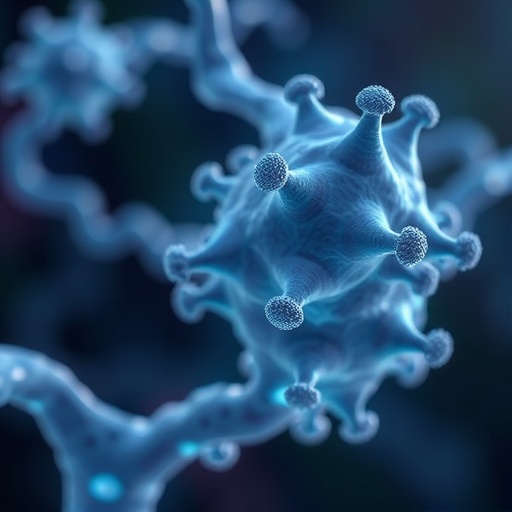A groundbreaking study published recently in the esteemed journal Aging-US uncovers a promising avenue for combating age-related physical decline by targeting the delicate glycocalyx layer lining blood vessels. Spearheaded by Daniel R. Machin and colleagues from the University of New Mexico School of Medicine and the University of Utah, the research provides compelling evidence that preserving the integrity of this microscopic vascular coating can stave off muscle loss and maintain exercise capacity in aging organisms. These insights open the door to novel therapeutic interventions designed to enhance healthspan by safeguarding vascular and muscular function.
The glycocalyx, a gel-like mesh composed primarily of glycoproteins and proteoglycans, serves as a critical interface between endothelial cells and circulating blood. Its integrity is essential for regulating vascular permeability, inhibiting leukocyte adhesion, and facilitating mechanotransduction—the process by which blood flow influences vascular tone and health. Unfortunately, extensive research has shown that this fragile lining deteriorates with advancing age, resulting in endothelial dysfunction, impaired microcirculation, and consequential tissue hypoxia. Such vascular perturbations contribute significantly to the onset of age-associated frailty and diminished physical performance.
Central to this study is the role of hyaluronan (HA), specifically high-molecular-weight hyaluronan (HMW-HA), an abundant polysaccharide component of the glycocalyx. The team elucidated the impact of genetically disrupting HA synthesis by deleting Has2, the enzyme responsible for producing HMW-HA, in murine models. Notably, mice deficient in Has2 exhibited a conspicuously thinner glycocalyx within their gastrocnemius muscle microvasculature. Despite retaining normal muscle size, these animals displayed marked declines in both exercise endurance and mitochondrial enzymatic activity, underscoring the mechanistic link between glycocalyx integrity and muscle metabolic health.
This genetic model provided a unique window into how isolated glycocalyx degradation compromises exercise capacity and muscle energetics independently of atrophy. The attenuated citrate synthase activity observed in affected mice signaled impaired mitochondrial function—a hallmark of reduced oxidative capacity and muscular endurance. These findings highlight the robustness of the glycocalyx as a determinant of physical function beyond conventional paradigms that focus solely on muscle mass loss.
Building on these molecular insights, the investigators explored the therapeutic potential of restoring glycocalyx composition using Endocalyx™, a dietary supplement enriched with exogenous HMW-HA. Over a 10-week intervention period, aging mice receiving Endocalyx™ demonstrated significantly preserved muscle mass compared with untreated controls, who experienced the typical trajectory of sarcopenia and weight loss. The supplemented group also outperformed controls on maximal treadmill running tests, exhibiting increased time to exhaustion and greater work output, albeit without a full reversion to youthful exercise capacity.
Mechanistically, the observed benefits are believed to derive from reinforced glycocalyx thickness and improved microvascular function, which collectively enhance blood flow dynamics and oxygen delivery during physical exertion. By stabilizing the endothelial barrier and reducing leukocyte adhesion, HMW-HA supplementation appears to mitigate chronic low-grade inflammation—a known driver of muscle catabolism and mitochondrial dysfunction. This vascular-centric approach thus represents a paradigm shift in addressing muscle aging by focusing upstream on vascular health rather than solely on muscle fibers.
Importantly, while Endocalyx™ attenuated declines in muscle strength and endurance, the partial nature of recovery suggests a multifactorial etiology for age-related physical dysfunction. Nonetheless, these results underscore the therapeutic promise of targeting the glycocalyx and provide a tangible framework for future research aimed at translational application in human elderly populations. Further clinical studies will be critical to validate safety, optimal dosing, and long-term outcomes of glycocalyx-targeted interventions.
The implications of this work extend beyond skeletal muscle health. Given the systemic role of the glycocalyx in cardiovascular homeostasis, its preservation may simultaneously reduce the burden of age-associated vascular diseases such as hypertension, atherosclerosis, and heart failure. Enhancing endothelial function could thereby confer holistic improvements in morbidity and quality of life for aging individuals.
This study also raises important questions regarding the interactions between dietary components, pharmacologic agents, and the endothelial glycocalyx. The ability to modulate this structure through nutraceuticals like HMW-HA signals a potentially accessible and non-invasive strategy that could be integrated into broader geroprotective regimens, including exercise and anti-inflammatory therapies.
Moreover, the delineation of Has2 as a pivotal enzyme for maintaining glycocalyx integrity paves the way for the development of gene-targeted or molecular therapies aimed at boosting endogenous HA synthesis. Such precision approaches could complement supplementation strategies, leading to synergistic effects in preserving vascular and muscular function.
In summary, the research conducted by Machin and colleagues offers robust evidence linking glycocalyx health to physical performance and muscle metabolism during aging. Their findings not only deepen our understanding of vascular contributions to frailty but also introduce a novel candidate intervention that could transform how aging-related decline is managed. As population aging accelerates worldwide, strategies preserving the glycocalyx may become central to extending healthspan and minimizing disability in later life.
Researchers and clinicians alike will watch with great interest as this promising field evolves through ongoing inquiries and clinical translation. The era of endothelial-targeted therapies for aging-associated physical impairment may soon be upon us, promising to reshape the landscape of geriatric health and mobility.
Subject of Research: Animals
Article Title: Glycocalyx-targeted therapy prevents age-related muscle loss and declines in maximal exercise capacity
News Publication Date: 30-Aug-2025
Web References: http://dx.doi.org/10.18632/aging.206313
Image Credits: Copyright: © 2025 Machin et al. This is an open access article distributed under the terms of the Creative Commons Attribution License (CC BY 4.0).
Keywords: glycocalyx, aging, hyaluronan, muscle loss, exercise capacity, vascular health, endothelial function, mitochondrial activity, sarcopenia, nutrition, geroprotection, microcirculation




